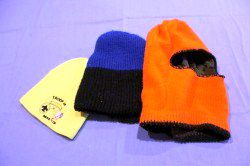Survival Gear Reviews
Buying the wrong gear or piece of equipment is a bad investment and a waste of resources. Hopefully, this collection of gear reviews will help you choose the right items for your particular needs.
Tuesday, January 13, 2015
Wednesday, December 17, 2014
Thursday, December 11, 2014
Sunday, March 31, 2013
The Bear Grylls Ultimate Survival Knife
I bought this knife. I received no compensation for writing this review.
I have avoided reviewing any Bear Grylls survival gear. I think Bear does crazy, foolhardy things on his show in the name of entertainment and sensationalism, and that somebody will die or get seriously injured following his example.
by Leon Pantenburg
But somebody is buying his line of survival products. In 2011 the Ultimate was the best-selling knife in the world. Gerber now makes the Ultimate Knife with a fine-edge from the top of the handle to the tip of the blade. There were some issues with the first series that came out two years ago, but the upgraded Ultimate model has apparently dealt with them.
I have received several requests asking for opinions about the new knife. So here we go.
On first blush, the knife has some features I like, such as the full-tang, five-inch drop point blade, a soft, easy to grip handle, and a ferrocerrium rod that fits in the sheath. It has a bright orange trim on the handle, which is important on a survival knife. People concerned with concealment can always cover the orange with camouflage duct tape.
Knife Features:
There is a diamond sharpener on the back of the sheath. It works fine, but most people probably don't have the skill to use such a sharpener.
I didn't like the sheath. The carrying loops on the back are too small for most belts, and it doesn't look particularly sturdy. The plastic part of the sheath appeared well-designed - all it needs is a better holder or platform.
Survival instructions: These are a collection of myths and misinformation. Some of the skills shown are way beyond a beginner to imtermediate's skill levels, and trying to learn and implement some of them during a survival situation is a recipe for disaster.
Overall, I'm lukewarm about this knife. It relies too heavily on Bear Gryll's celebrity and too little on sound design and quality. While it's not a bad knife, it is just not a very good knife or something I would stake my safety on.
I won't buy another Ultimate. But I would suggest this to Gerber: Take your knife design, leave the handle as it is, and put some good steel in the blade. Keep the plastic part of the sheath, with the ferro rod, and attach it to a better platform that allows for comfortable carry. Get rid of the diamond sharpener.
Stay with Bear for the PR and advertising aspect - he is fooling millions of people with his survival shenanigans and you are benefiting too. But dump the "Priorites of Survival" tips and get an expert, such as Peter Kummerfeldt, to write something practical.
Do some tweaking - then you will have a quality product you can be proud of.
(Check out "The Best Survival Knife?" blog by clicking here!)
I have avoided reviewing any Bear Grylls survival gear. I think Bear does crazy, foolhardy things on his show in the name of entertainment and sensationalism, and that somebody will die or get seriously injured following his example.
by Leon Pantenburg
But somebody is buying his line of survival products. In 2011 the Ultimate was the best-selling knife in the world. Gerber now makes the Ultimate Knife with a fine-edge from the top of the handle to the tip of the blade. There were some issues with the first series that came out two years ago, but the upgraded Ultimate model has apparently dealt with them.
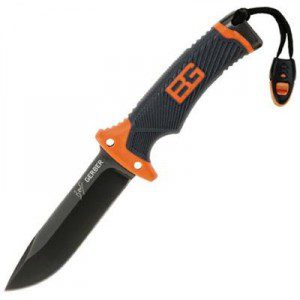 |
| The Bear Grylls Ultimate survival Knife |
On first blush, the knife has some features I like, such as the full-tang, five-inch drop point blade, a soft, easy to grip handle, and a ferrocerrium rod that fits in the sheath. It has a bright orange trim on the handle, which is important on a survival knife. People concerned with concealment can always cover the orange with camouflage duct tape.
Knife Features:
- High Carbon Stainless Steel Drop Point Blade. Gone are the serrations. People either love or hate serrated edges, and I hate them. IMO, serrations are a specialty edge that most people won't need or use. When they dull, sharpening serrations takes skill and a specialized tool.
- Ergonomic Textured Rubber Grip - Maximizes comfort and reduces slippage. Thanks goodness, there was no hollow handle full of junk! A non-slip handle is a requirement for a knife that will be used in hunting or survival situations. Dress out a big game animal, and you will inevitably get blood and other fluids on the handle. If your hand slips onto the blade, it could be really, really bad.
- Stainless Steel Pommel - At base of handle for hammering. In some 40 years of kicking around the backcounty, I have never had occasion to pound on something with the pommel of a knife. Pick up a rock or stick to do any hammering. Don't risk your knife.
- Emergency Whistle - Integrated into lanyard cord. This is loud and handy, as it should be. I always carry a couple of whistles, and this feature is valuable.
- Sheath Features:
- Fire Starter - Ferrocerium rod locks into sheath, striker notch incorporated into back of knife blade. This is a good addition to any survival knife system.
- Nylon Sheath - Lightweight, military-grade, mildew resistant.
- Land to air rescue instructions - These are things you should learn or already know. Having a reminder along on the back of the sheath is not a bad idea.
- Diamond Sharpener - Integrated into sheath for on-the-go sharpening.
- Priorities of Survival - Pocket guide contains Bear’s survival essentials.
I chopped some carrots and cut up and disjointed a chicken, and sliced some steak. No problem, and it held its edge. The handle is comfortable and non-slip. Then I cut up some corrugated cardboard, one of the most abrasive and knife-dulling materials imaginable. The edge held up OK. I cut the cardboard until the blade lost its razor edge, then touched it up with a butcher's steel. A few swipes restored the blade to its former sharpness.
Next, I whittled on a hard, old pine stick until the knife started to get hard to use. It didn't take long for the edge to lose its sharpness. IMO, it dulled too easily, which would indicate an inferior or too-soft steel.
There is a diamond sharpener on the back of the sheath. It works fine, but most people probably don't have the skill to use such a sharpener.
I didn't like the sheath. The carrying loops on the back are too small for most belts, and it doesn't look particularly sturdy. The plastic part of the sheath appeared well-designed - all it needs is a better holder or platform.
 |
| I designed this prototype Jim Grenfell hollow handle survival knife. It has a five-inch drop point blade. (Pantenburg photo) |
Overall, I'm lukewarm about this knife. It relies too heavily on Bear Gryll's celebrity and too little on sound design and quality. While it's not a bad knife, it is just not a very good knife or something I would stake my safety on.
I won't buy another Ultimate. But I would suggest this to Gerber: Take your knife design, leave the handle as it is, and put some good steel in the blade. Keep the plastic part of the sheath, with the ferro rod, and attach it to a better platform that allows for comfortable carry. Get rid of the diamond sharpener.
Stay with Bear for the PR and advertising aspect - he is fooling millions of people with his survival shenanigans and you are benefiting too. But dump the "Priorites of Survival" tips and get an expert, such as Peter Kummerfeldt, to write something practical.
Do some tweaking - then you will have a quality product you can be proud of.
(Check out "The Best Survival Knife?" blog by clicking here!)
Sunday, December 30, 2012
Video: Include a stocking cap in your survival gear
About 10 percent of your body heat exits through your head. Conversely, sun beating down on an unprotected head can cause sunstroke, headaches and severe sunburn. A stocking cap may be what you need to handle both of these circumstances.
by Leon Pantenburg
Balding, middle-aged men like me develop a real affection for hats that work well. I always wear some sort of head covering outdoors, and generally it will be some sort of broad-brimmed type.
But I also carry a stocking cap in my survival gear. A stocking hat, by way of (my) definition, is a loose knit, form-fitting cap, made of natural or synthetic fibers. The proper stocking hat can handle two vastly different scenarios.
Check out the video below!
Heat:
Mississippi has got to be one of the most hot, humid places anywhere during the summer months. At least it is, when you're wearing a wool uniform.
One summer, I was a Volunteer in the Park at Vicksburg National Military Park. I dressed in authentic Civil War clothing, and was part of a cannon crew that fired a 12-pound Napoleon for tourists. Also, as a Vicksburg Post staff reporter, I was drafted and "embedded" into a Confederate infantry unit at a couple of local re-enactments. (I protested vigorously, in the tradition of all conscripts, and pointed out the perfidy of the southern cause. At one point, I refused to stand and sing "Dixie" along with the other re-enactors. For this transgression, I was tied to a cannon in front of the Old Court House Museum as an example to other malcontents.)
At one of these living history events, I noticed a soldier wearing a stocking cap, drilling in the hot Mississippi sun. He claimed it kept him cool.
"It's cotton, and hand-knit by my sister," he told me. "I soak it in water before we hit the field, and the evaporation keeps me cool."
For improved sun protection, he sometimes wore a broad-brimmed straw planter's hat over the wet cap. The stocking cap provided insulation from the tropical sun and a source of water for evaporation. The straw hat shaded his head, face and neck. All his modern sun protection needs were taken care of very effectively by old-time technology.
This is a technique that can be adapted to your desert or hot weather hiking with a cotton stocking cap. The cap will be warm at night until it gets wet. In the daytime, soak it in water to help cool your head. This cap (unless it's a beanie) can also be pulled down over your eyes, ears, nose and neck for sun protection. A cotton bandana can also be put into service in a similar manner.
Cold: People think of thick, wool caps when they think of winter wear. I do.
One of my favorite hunting caps is a reversible camouflage/blaze orange synthetic ski-mask. I seldom pull the cap down over my face, but I know the option is there. When big game hunting, I wear the orange side out. When after waterfowl, the camo is used. In those instances, the face covering may be used to help hide my face.
A stocking cap is great to wear for stalking through deep woods, or when there is a lot of bush to go through.
My collection of stocking caps range from light to heavy. I may start out wearing a stocking cap, and then layer another on top if weather conditions call for it.
Despite the versatility of this head covering, there are a few things to consider before buying one.

by Leon Pantenburg
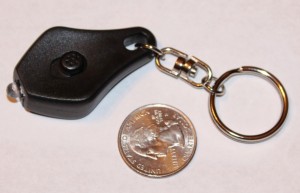 |
| Check out this light! |
Balding, middle-aged men like me develop a real affection for hats that work well. I always wear some sort of head covering outdoors, and generally it will be some sort of broad-brimmed type.
But I also carry a stocking cap in my survival gear. A stocking hat, by way of (my) definition, is a loose knit, form-fitting cap, made of natural or synthetic fibers. The proper stocking hat can handle two vastly different scenarios.
Check out the video below!
Heat:
Mississippi has got to be one of the most hot, humid places anywhere during the summer months. At least it is, when you're wearing a wool uniform.
One summer, I was a Volunteer in the Park at Vicksburg National Military Park. I dressed in authentic Civil War clothing, and was part of a cannon crew that fired a 12-pound Napoleon for tourists. Also, as a Vicksburg Post staff reporter, I was drafted and "embedded" into a Confederate infantry unit at a couple of local re-enactments. (I protested vigorously, in the tradition of all conscripts, and pointed out the perfidy of the southern cause. At one point, I refused to stand and sing "Dixie" along with the other re-enactors. For this transgression, I was tied to a cannon in front of the Old Court House Museum as an example to other malcontents.)
At one of these living history events, I noticed a soldier wearing a stocking cap, drilling in the hot Mississippi sun. He claimed it kept him cool.
"It's cotton, and hand-knit by my sister," he told me. "I soak it in water before we hit the field, and the evaporation keeps me cool."
For improved sun protection, he sometimes wore a broad-brimmed straw planter's hat over the wet cap. The stocking cap provided insulation from the tropical sun and a source of water for evaporation. The straw hat shaded his head, face and neck. All his modern sun protection needs were taken care of very effectively by old-time technology.
This is a technique that can be adapted to your desert or hot weather hiking with a cotton stocking cap. The cap will be warm at night until it gets wet. In the daytime, soak it in water to help cool your head. This cap (unless it's a beanie) can also be pulled down over your eyes, ears, nose and neck for sun protection. A cotton bandana can also be put into service in a similar manner.
Cold: People think of thick, wool caps when they think of winter wear. I do.
One of my favorite hunting caps is a reversible camouflage/blaze orange synthetic ski-mask. I seldom pull the cap down over my face, but I know the option is there. When big game hunting, I wear the orange side out. When after waterfowl, the camo is used. In those instances, the face covering may be used to help hide my face.
A stocking cap is great to wear for stalking through deep woods, or when there is a lot of bush to go through.
 |
| I prefer a broad-brimmed wood hat for most of my outdoors wear, but also carry a stocking hat as a backup. |
Despite the versatility of this head covering, there are a few things to consider before buying one.
- Material: Don't buy a cotton cap for cold weather or a wool one for heat. The material of the cap will help determine when it should be used, and you don't want to get them mixed up. Wool stays warm when wet, which makes it a bad choice for dealing with the heat.
- Weave: A tight-knit hat will tend to be warm, and a loose construction will allow heat to dissipate quicker. Don't get a loose weave cap for warmth.
- Size: A beanie is typically not large enough to cover your face and nose if needed. Conversely, a large hat may be bulky and too hot.
Paracord: You can't get along without it
Among the many survival tips I have learned from Peter Kummerfeldt is to always carry paracord as part of my emergency gear. I have used it for everything imaginable, and you will too!
by Peter Kummerfeldt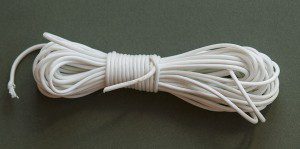 |
| 550 cord, paraline, paracord, parachute line, call it what you will, 150 feet of mil-spec parachute line should be a part of your gear. (Peter Kummerfeldt photos) |
As I think back over nearly 46 years of teaching survival skills and about the same amount of time beating about the bush, I don't think I have ever been without some parachute cord. I have used to to build shelters, catch fish, weave nets, make stronger rope, for emergency dental floss, as sewing thread, to retrieve water when I was cliff-bound and yes, parachute line has lowered me to the ground when I jumped out of an airplane while I was in the Air Force. Simply put it can truly be a life saver!
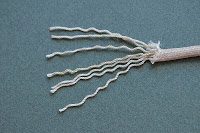 |
| Paracord is made of several nylon fibers, which gives it a strong tensile strength. |
What is parachute line? Parachute line is made up of a tubular case containing seven pieces of thinner, nylon threads each of which can be further separated into three even finer threads.
 |
| Each fiber has about 35 pounds of strength. |
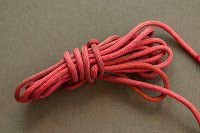 |
| Make sure you can see your paracord. |
I recommend buying white cord and then dying it bright red or orange so that you can find it if you drop the line on the ground or worse still, on snow.
RIT fabric dye works well. Make a concentrated solution and then drop your parachute line into it and leave it there until you are happy with the color. Before you remove it from the dye pour in a cup of vinegar to set the dye and let it sit some more - a couple of days. If you don't do this, since nylon doesn't take up dye very well, the dye will come off in your hands.
Stronger rope can be made from parachute line by either twisting two ropes together or by braiding three or more pieces together.
As I said in the beginning, 150 feet in 25 foot lengths, should be included in your gear. There's no way to improvise a line from natural resources that comes close to the strength, utility and usefulness of parachute line. Check out this paracord.
Peter Kummerfeldt has walked the talk in the wilderness survival field for decades.
Peter grew up in Kenya, East Africa and came to America in 1965 and joined the U.S. Air Force. He is a graduate of the Air Force Survival Instructor Training School and has served as an instructor at the Basic Survival School, Spokane, Washington; the Arctic Survival School, Fairbanks, Alaska, and the Jungle Survival School, Republic of the Philippines.
 |
| Peter Kummerfeldt |
For twelve years, Peter was the Survival Training Director at the United States Air Force Academy, Colorado Springs, Colorado. He retired from the Air Force in 1995 after 30 years of service.
In 1992, concerned with the number of accidents that were occurring in the outdoors annually and the number of tourists traveling overseas who were involved in unpleasant and sometimes life-threatening incidents Peter created
He is the author of “Surviving a Wilderness Emergency” and has addressed over 20,000 people as the featured speaker at numerous seminars, conferences and national conventions.
Check out Peter’s blog at: OutdoorSafe.blogspot.com
Subscribe to:
Posts (Atom)
